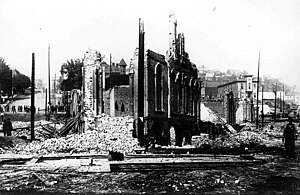I was looking forward to my tour of 'Underground Seattle," the widely-popular tour through the lower levels of buildings around Pioneer Square. In my mind, it would be a stunning window into history, lined with interesting artifacts. And it was, sort of...
But what it mostly was is an entertaining underground comedy club. The remains of earlier building use are there, mostly jumbled and uncared for beyond safety measures, but what makes "Bill Speidel's Underground Tour" are the guides and their corny canned history, filled with jokes about drunks, politicians, idiots and, notably, Tacoma, Seattle's one-time rival for Northwest dominance.
There are also a number of variations; an adult-only one features more stories about the area's prostitution history and another features ghost stories. But the main, or regular, tour is the most popular.
It starts in what appears to be an abandoned barroom from some decade or another; before the pandemic drinks and snacks were available there and will be again. When everyone's gathered for the tour, the audience moves to a basement room that connects to the tunnels for an introductory 'lecture' by the guides.
The lecture includes a history of the Pioneer Square area, one of Seattle's earliest settled areas, complete with fairly graphic descriptions of the sorts of sewage that regularly poured through the area, flowing downhill into Elliott Bay, and how various early businessmen tried to dominate the city through a variety of means mostly legal but often unethical.
And those stories extended to tales of how Seattle and Tacoma had competed to be the western terminus of the second transcontinental railroad (Tacoma won, and we were warned to boo loudly whenever Tacoma was mentioned.)

But the big event, both for early Seattle and for the tour, was the Great Fire of 1889, which destroyed most of the city, leaving only the few brick or stone facades standing; as a city whose biggest industry at the time was logging, it's no surprise that nearly everything was built of wood.
Downtown Seattle before the fire
The fire itself, which destroyed nearly 500 buildings, is part of the guides' routines, with comic expressions and mock surprise at how slowly some responded. The fire started when a carpenter's apprentice spilled a boiling glue pot, which set fire to wood shavings, which burnt through the ceiling into a paint store, where the volatile paint and solvents exploded. Next was a liquor store, with obvious results.
Below the Northern Hotel, and a bar rescued from its basement and set up in the tunnel for the tour.
Seattle already had an active volunteer fire department, which showed up promptly with all their equipment; they only thing they were lacking was water. Elliott Bay was too far down to be used, and the local water supply, which only had hydrants every two blocks, used hollow-log pipes that couldn't provide much water.
After the fire, the city made several important decisions. First, the rebuilding would be masonry, not wood, and second, the hills would be smoothed out and the street levels would be raised to allow proper sewers and other utilities. And there would be a proper system of water and hydrants.
Rebuilding began almost immediately, but but the decision to raise the streets led to a unique solution. The new buildings went up on the old sites, but in the meantime, the city built walls, some as high as twenty feet, along the streets. That's where the sewers and utilities were placed, and the area between the walls would eventually be filled to provide a new street surface.
Outside the walls, new sidewalks were constructed, connecting to the second, or in some cases third floors of the new buildings. As each street was completed, the businesses moved up from what was now a basement to the new street level. The new sidewalks were equipped with glass 'lights' to allow the space under them to still be usable, and some businesses kept using the now underground spaces.
Over the years, most of the basement space was either abandoned or turned into storage; in 1907, it was sealed off because of a bubonic plague scare. And so it sat, mostly filled with junk—some of it tossed in long after sealing—until the 1960s, when Bill Speidel, a local journalist and publicist led a campaign against a city plan to seal and fill, and the Underground Seattle tour was born.
Walking through the spaces with the tour group included stops at various points for more narration, more facts, more laughs. And, like all good tours must, it ended with an exit through the souvenir store.

Comments (0)